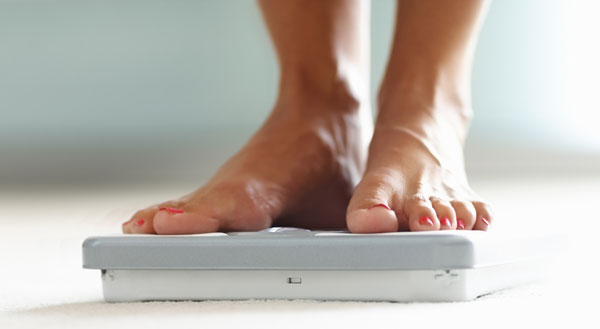Becoming happier, saving more money, falling in love, and spending more time reading are all perennial favorites among Americans’ New Year’s resolutions. But year after year—according to online polls and other surveys—the number one spot remains the same: losing weight. If you’re an optimist, you might interpret that as a sign that we’re facing up to the national obesity epidemic; 68 percent of U.S. adults are overweight or obese. But if you’re a realist, you may see the unending quest for weight loss differently—as evidence that shedding pounds and keeping them off seems to be harder than growing a third arm.
Why? Or, as anyone who has tried and tried but failed and failed to permanently slim down might put it, “Why??!!” If you read the testimonials from people who lost 50, 100, or more pounds on a commercial diet or the seemingly sure-fire advice from health magazines (eat pistachios! try grapefruit!), losing weight is easy. But here’s the irony: There are almost as many ways to successfully lose weight as there are people who need to do so.
To name but a few examples, drinking lots of water does make you feel fuller and therefore likely to eat less. (In one study, drinking 16 ounces of water before a meal led to 5 extra pounds of weight loss after 12 weeks—people felt too full to eat more.) Eating soup for dinner does, indeed, fill you up (again, with water), making it easier to eat less. Covering two-thirds of your plate with vegetables (no cream sauce!) leaves less room for calorie-laden meats and starches, reducing caloric intake. Cutting out booze, sugar- or fat-laden drinks (that includes lattes), potato chips, baked desserts—you know the list—does help. But knowing what works and doing what works are two different things.
Just in time for 2012, research is finally addressing the “doing” part. From psychological tactics such as exploiting the power of groups to a new understanding of metabolism, science has more to offer dieters than ever before, providing guidance about which diet and exercise regimens offer the best chance to help you lose weight and become fitter.
Take the most fundamental of dieting basics: that weight drops when and only when the number of calories you burn exceeds the number you take in. Experts now recognize that both sides of the energy/balance equation—calories burned and calories consumed—are not as simple as how much you exercise and how many calories are in the food that passes your lips. “The conventional thinking about calories in/calories out is changing, as research shows that people have different reactions to different macronutrients,” says Dr. Richard Kreider, professor of health and kinesiology at Texas A&M University. “That’s why no one diet or exercise plan works for every individual. If everyone cut their intake 500 calories a day and exercised an hour more, it would have different effects on different people.”
Let’s start with calories burned. Don’t be discouraged by the paltry number you burn during exercise (for a 160-pound person, 288 calories in a leisurely one-hour bike ride, for example, or 317 in a one-hour walk at 3 miles per hour—in both cases, barely enough to burn off a couple of scrambled eggs on unbuttered toast). Instead, emphasize the kind of exercise that can increase your metabolism so you burn more calories doing “nothing.” Fidgety people tend to be slimmer; burning extra calories for, say, 16 hours per waking day, seven days a week, adds up to more than you get by brief and sporadic bursts of exercise. That doesn’t mean we should all start fidgeting. But the basic principle means that it helps to incorporate resistance (or strength) training into your regimen. Leg lifts, situps, squats, and the like build muscle, notes Kreider. A pound of muscle burns more calories than a pound of fat. Therefore, replacing fat with muscle will raise your baseline metabolism. “You burn more calories after your workout as well as during,” Kreider says.
Slashing your caloric intake, on the other hand, lowers baseline metabolism. This is why so many people are yo-yo dieters. They shed pounds by limiting their calories to, say, 1,200 a day, but because very low-calorie diets tend to take off muscle (in many cases, half or more of the lost pounds are muscle) the result is an increasingly lower metabolism. Eventually it gets so low, says Kreider, that you have to practically starve yourself to keep from gaining weight.
Starving yourself is not fun, in case you hadn’t noticed. And being miserable on a diet is also a big reason people give up, setting the stage for next year’s New Year’s resolution. Very low-cal diets can trip you up for another reason. A study published online last September in The Journal of Clinical Investigation found that when glucose levels drop, as happens when we consume too little, the brain’s hypothalamus senses the change and activates the brain’s insula and striatum, which are associated with reward, inducing a desire to eat. At the same time, the prefrontal cortex seems to lose its ability to put the brakes upon the “EAT! EAT!” signals coming from the striatum. That impairs the ability to inhibit the impulse to eat when glucose levels plunge, explained Dr. Kathleen Page of the University of Southern California, who led the study.
Different foods can raise or lower your baseline metabolism. To lose weight, you want more of the former without compromising nutrition. Green tea and caffeine raise baseline metabolism. And because muscle burns more calories than fat, foods that build muscle—namely, those high in protein—will indirectly raise your metabolism just as resistance training does. Calories from protein also take more calorie-burning energy to digest and leave you feeling fuller than calories from carbohydrates. High-fiber grains are a close second followed by fruits and vegetables with starches and sugars trailing badly. If a diet leaves you feeling full, you are more likely to stick to it, making it a true lifestyle change and not an eight-week crash program. The realization that foods differ in how full they leave you led Weight Watchers to revamp its famous points system a year ago. A PB&J on white bread with chips sets you back 11 points, but so does a heaping Greek salad, soup, pasta, and grapes, which is much more filling. The idea is to use your points on foods like the latter.
The protein effect helps explain why, in a 2011 Consumer Reports analysis, Jenny Craig, Slim-Fast, and Weight Watchers were all good to excellent at both short- and long-term weight loss and adherence (Jenny Craig came out on top). These diets are effective because they get 20 percent or more of calories from protein (experts suggest going as high as 30 percent) and include at least 21 grams of fiber for every 1,000 calories. How much of a difference can protein and resistance training make? Kreider put patients on a 2,600-calorie-a-day regimen—800 more than they’d been on during an earlier weight-loss diet—plus exercise. They had very low resting metabolisms, probably a result of their low energy intake. But the patients lost weight on the higher-cal diet; its higher protein content and resistance training built muscle and raised baseline metabolism. “Higher protein intake can also lead to changes in gene expression that make you burn fat more effectively,” says Kreider. It never hurts to have your DNA on board.
One reason Jenny Craig edged its competitors is that it offers single-serving entrees, desserts, and snacks (1,315 calories a day), removing the element of choice. That may sound restrictive, but many dieters are relieved to outsource such decisions. “They’re very effective for some people,” says Dr. John Foreyt, a professor at Baylor College of Medicine and director of its Behavioral Medicine Research Center. In fact, “some people” seems to be “many people.” Strictly prescribed plans tend to have lower drop-out rates both long-term (one year or more) and short-term (less than six months), Consumer Reports found.
On a structured eating plan you are also less likely to eat anything actively bad for you such as foods containing high fructose corn syrup (HFCS). Here is another example of how not all calories are created equal. Although HFCS has no more calories than other sugars, its effect on the brain and body seem to be different, says Dr. Richard Shriner, director of the eating orders and obesity program at the University of Florida, Gainesville. It reduces levels of leptin, the appetite hormone that signals us that we’re full. Shriner calls HFCS a “bariatric food”—a food that alters our physiology in a way that promotes more weight gain than its calorie count would indicate.
The most important factor in whether you will lose weight on a diet is whether you can stay on it. That may partly explain the edge that low-carb diets have over low-fat diets. Low-fat diets are necessarily lower-protein diets because most proteins (meat, dairy, nuts) come with fat. “A low-fat diet is like eating cardboard,” says Foreyt. “You feel hungry and unhappy. For long-term success, a diet has to be tailored to your likes and dislikes.”
Foreyt’s statement is supported by a 2010 study in the New England Journal of Medicine in which fewer people on high-protein diets (like Atkins) dropped out than on low-protein-high-carb diets (26 percent vs. 37 percent).
Exercise plays a role in adherence, too. It promotes a sense of well-being thanks to its ability to raise levels of endorphins and other feel-good chemicals in the brain. “And if you feel better about yourself, you’re more likely to stick to a diet,” says Foreyt. That said, it’s just about impossible to lose weight by ramping up physical activity if you don’t change what you eat. A 2011 analysis of 14 exercise studies, which included 1,847 overweight patients, with aerobic exercise programs ranging from 12 weeks to 12 months found an average weight loss of 3.5 pounds after six months and 3.7 pounds after 12. Or as the scientists from McGill University in Montreal concluded, “isolated aerobic exercise is not an effective weight loss therapy.” For exercise to help, it must be “in conjunction with diets.”
The realization that many diets work as long as people stick to them, and that what matters for any individual is whether he or she can do that, has led weight-loss experts to recognize the crucial role that psychology plays in efforts to slim down. Jenny Craig offers counseling sessions, and Weight Watchers has weekly meetings. Curves offers 30-minute structured resistance and aerobic exercise workouts—30 minutes, 500 calories, plus residual metabolism increase. The importance of exercise to build metabolism-raising muscle as well as burn calories means that social support making you more likely to work out can mean the difference between success and failure. “If you want to lose weight, don’t go it alone, especially for exercise,” says Kreider. Try a buddy system. “Trying to lose weight can be a very lonely experience,” says Shriner. “When you’re staring at the fridge at 2 a.m. and are about to binge, have a friend you can call.”
Research has now focused in on what other kinds of psychological support are most helpful, and the winner so far is cognitive behavioral therapy (CBT). In this approach, which has also proven effective in mental illnesses such as depression, a therapist helps people recognize the negative thoughts that may be keeping them from losing weight, especially the idea that having failed before (as is true for most dieters) means they will fail again. CBT “helps make people aware of what they are telling themselves, especially in the aftermath of a multitude of previous failures,” says Brent Van Dorsten, a clinical health psychologist at the University of Colorado School of Medicine in Denver. A 2005 review of 36 studies with 3,595 participants by the Cochrane Collaboration, an international group of scientific and medical experts, found that CBT “significantly improved the success of weight loss” compared to diet and exercise alone. “We now have years of research showing that cognitive and behavioral components make a real difference in weight-loss programs,” says Van Dorsten. “When therapists help you set a realistic and clearly defined weight-loss goal, combine several dietary and physical activity strategies, and keep you from catastrophizing”—that is, concluding from one slip-up at the dessert table that you are doomed to fail again—“all of these improve long-term weight loss.”
The use of CBT is part of a sea change in the science of weight loss, which recognizes that what happens inside your skull is as important as what happens inside your digestive system. For instance, a 2011 study by scientists at Yale found that when people thought of a food (in this case, a milk shake) as rich, indulgent, and loaded with calories, after drinking it people’s levels of the hunger hormone ghrelin fell off a cliff; they couldn’t eat another bite. But when people thought of the same food as low-cal and “sensible,” their ghrelin levels hardly budged after they drank it; they were still hungry. That offers another explanation of why “diet” foods don’t work—we think they’re about as filling as a carrot, and that becomes a self-fulfilling prophecy. Lesson: Persuade yourself that the foods on your meal plan are filling and indulgent.
At the end of the day, eating sensibly and exercising requires will power. Here, too, science is revealing previously unsuspected aspects of this precious commodity.
Psychologist Roy Baumeister of Florida State University has shown that will power is a finite resource just like, say, energy; if you use a lot of it for one thing you have less left for another. People who are on a strict diet have trouble resisting the siren call of buying, for instance. Having deployed their self-restraint on passing up dessert at lunch with friends, they have none left to resist that amazing pair of shoes calling to them from the shop window.
And, if all else fails, there’s always New Year 2013!
Easy Rules for a Stay-Slim Life
Will power is limited. Arrange your life so you don’t need to tap into it so often.
Shop lite.
Don’t buy calorie-laden, temptation foods in the first place. If you do buy them, put them as far out of sight and reach as possible.
Eat at home.
Scarfing down thousands of calories at a restaurant is just too easy.
Keep a journal.
Make a record of your weight-loss project—and don’t skimp on the self-praise. On a day when you couldn’t resist the ham, cheese, and mayo-stuffed triple-decker, seeing how abstemious you were on days past can be a real confidence builder.
Sleep better. 
Because sleep deprivation can sap will power, make seven or eight hours per night of shut-eye a priority.
Reward yourself.
Everyone needs rewards, and frequent little ones can help will power. Try incorporating a treat into your weight-loss regimen. A 2011 study in the Journal of the American Dietetic Association found that dieters who ate one dark chocolate each day lost the same 11 pounds over 18 weeks as those eating the same foods but without the chocolate.
Don’t Overdo it. 
Pledging to lose weight is hard enough, and trying to make other lifestyle changes at the same time will weaken your overall resolve. Get real! You can’t have it all. Don’t start a stressful project at work or at home just as you launch your weight-loss plan.
Eat More often!
Another tip that has emerged from a better understanding of physiology and physiology is that eating stimulates the digestive system to store glucose and fat, which increases metabolism and quells appetite. Between meals, fat and glucose are released from storage to keep our cells running, and metabolism slows. Bottom line: Many dieters have better results if they eat five small meals a day rather than three large ones. Eating more often keeps metabolism elevated and prevents the blood-sugar crashes that can make you devour an entire pint of Ben & Jerry’s. In contrast, if you eat fewer than 1,200 calories a day, your body, which thinks famine is at hand, hunkers down in survival mode, slowing down your metabolism and promoting fat storage. And feeling chronically hungry eventually makes all but the most self-flagellating of us abandon the diet.
Become a Saturday Evening Post member and enjoy unlimited access. Subscribe now



